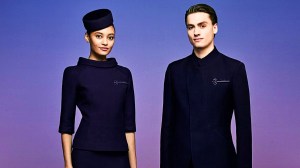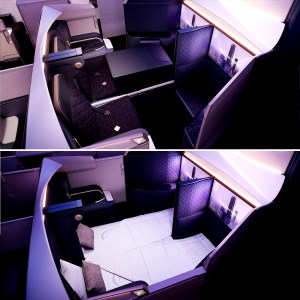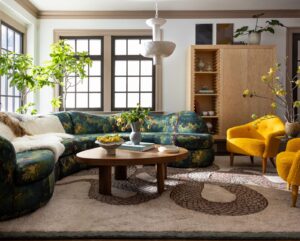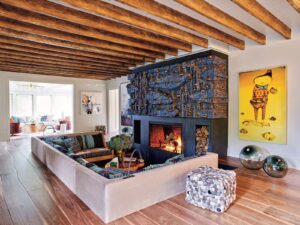The trend these days among a number of air carriers is to raise business class to a level that competitors call first class. Start-up airline Riyadh Air plans to follow that game plan with its initial fleet of Boeing 787-9 airliners, scheduled to start operations by the end of 2025.
Unlike other cash-starved start-ups, Riyadh Air will have the backing of the Saudi Arabia‘s sovereign wealth fund, the Public Investment Fund (PIF), which means extremely deep pockets to create a first-class experience at business-class rates. “We want to bring back grace, beauty, and charm,” Riyadh Air CEO Tony Douglas tells Robb Report. “We want a modern-day version of TWA or Pan Am at their height in the 1960s, like Leonardo DiCaprio in Catch Me if You Can, but with a modernistic twist.”
The Luxury Plus pods as either seats or lie-flat beds.
Riyadh Air
The executive team has taken a pedantic interest in meticulously crafting the image of the airline, from liveries that resemble a rock band’s private jet, to the spiffy, almost futuristic crew uniforms it introduced at Paris Fashion Week.
But beyond the public-facing aircraft and staff, its business-class section is a tasteful collection of colors and materials, shaped into what Douglas calls a “signature geometry” loosely inspired by a Bedouin tent that adds subtle curves across the business-class area. “It has an obsessional level of detail throughout,” Douglas says. “We believe the cabin is going to stand out from the crowd because of its elegance and refinement. We call it the art of design.”
The cabin’s design by PriestmanGoode is full-out luxe in the business-class section, including the four Business Elite seats and 24 other Business seats. The lighting is subtle, and the details of the seating areas include rich-purple textures as well as indigo, mocha, skyline blue, lavender. The stitching in the upholstery is reminiscent of a supercar, and the mocha-hued stoned accents with gold veins in the side rests and tray tables deliver a tasteful, subtle blend with the overall design.

The flashy livery is more like a private jet.
Riyadh Air
The Business Elite seats in the first row have two seats that can be combined into a double bed, and the section also features a 32-inch 4K OLED IFE screen, which Riyadh refers to as the “world’s largest business class screen,” compared to 22 inches in standard business. All seats are configured 1-2-1, with a seat width of 22.5 inches, a 78-inch fully flat bed, and 52-inch-high walls with sliding privacy doors.
The airline is particularly proud of the Safran Unity seats, which include built-in speakers from Devialet, to offer an immersive surround-sound experience in the headrest that doesn’t travel to other seat areas. Riyadh will be one of the first to offer the ergonomically advanced Safran Unity seats, which made their debut in Japan Airlines’s first-class section this year.

Speakers embedded in the headrest provide a surround-sound experience without headsets or ear pods.
Riyadh is also calling itself the world’s first “digital-native” airline, which refers partly to free Wi-Fi across the cabin, via Viasat onboard streaming, but also to the customer experience of booking a flight.
“We wanted to be a start-up that embraces technology in a different way,” says Douglas. “We’re now in what we call our 2.0 version and will be releasing the 3.0 version in a few months. That will make us more like what you do with Amazon and its shopping basket.” The system will allow passengers to book as a single party as well as experiences at the destination like visiting a museum or art gallery.

Even the flight attendants’ uniforms, first shown at Paris Fashion Week, project a modern look.
The company declined to reveal its initial destinations until it opens its platform for booking at an undisclosed time, but Douglas says the list should include capitals of Western Europe and North America. Its central hub will be Riyadh.
The start-up eventually plans to have 100 destinations around the world as it transitions to the country’s primary carrier. On an as-of-yet-unannounced aircraft type, Riyadh plans to introduce a first class section that is even more lavish than its business class.
The rise of a contemporary start-up airline coincides with Saudi Arabia’s plan to expand its tourism base as the Kingdom attempts to move its image away from a wealthy but inward-focused country to a more modern, moderate version. The long-term goal is to supplement oil revenues with tourism. A recent report said that after opening its borders in 2019, Saudi Arabia has seen annual tourist visits growing from 17.5 million in 2019 to 30 million last year.
Credit: robbreport.com











